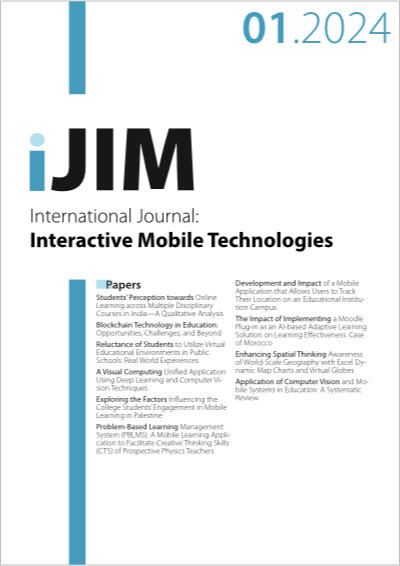Development and Impact of a Mobile Application that Allows Users to Track Their Location on an Educational Institution Campus
DOI:
https://doi.org/10.3991/ijim.v18i01.42905Keywords:
mobile application, geographic information systems, academic institutions, georeferencing, 360 viewsAbstract
This research study aims to solve user location issues within the campus at an educational institution. As this campus comprises a large number of places and departments, users often get confused about how to reach a specific location. To address this problem, the “Ubícate” (“locate by yourself” in Spanish) application was developed following the CDIO methodology, which encompasses four creative process steps: conceive, design, implement, and operate. The “Ubícate” app provides users with information on places of interest such as schools, departments, halls, auditoriums, and sports venues, offering a visual reference of available locations through 360-degree images. The application also uses Google Maps to track user location within the campus, thus marking a reference route between university gates and the different locations available, in addition to providing information on university-sponsored events. In this paper, Section 2 describes the methodology and each of the stages that were addressed in the following sections. Section 3 presents the development itself and the data used for the purposes thereof. Next, Section 4 reveals the results from this study. Later, Section 5 assesses these results and the findings from the study. In Section 6, our conclusions are discussed. Finally, Section 7 lists topics for future research. The application did indeed contribute to improving the attendance of the academic community at events. Where the application was used, the first-hand perception of visitors and their own was very positive and enhanced the institutional image and sense of belonging. The contribution of this study consists of presenting a mobile application as a solution from three approaches: the technical aspects for application development, the business vision to satisfy the user’s needs, and the end user’s perception. All three approaches provide a technical reader, an entrepreneur, or an end user an overview of a scalable solution to different types of implementations in different types of businesses that require indoor location through the use of technologies in mobile applications. The mobile application performs the location indoors using the Google Maps platform, allowing a more agile development in implementing the APP.
Downloads
Published
How to Cite
Issue
Section
License
Copyright (c) 2023 Carlos Andrés Tavera Romero, Professor Patricia Segovia, Professor María Fernanda Díaz, Engineer Diego Fernando Pérez

This work is licensed under a Creative Commons Attribution 4.0 International License.


